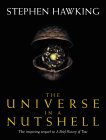'The Universe in a Nutshell'

The universe in a nutshell
Stephen Hawking
What is the nature of the universe that we live in? This is a question that has exercised philosophers and scientists for as long as people have been able to think. Almost everyone has asked it at one time or another, in one form or another. It is hard to imagine a more fundamental question. The phenomenal success of Stephen Hawking's first popular book, A brief history of time, first published in 1988, testifies to the hunger for understanding that is part of the human condition.The universe in a nutshell is billed as "the inspiring sequel to A brief history of time". It is of course not really a sequel at all; it is rather, as Hawking might put it, orthogonal to the earlier book. A brief history presented the best picture of the Universe we had at the time. It examined the overall shape of the universe (is it expanding? How did it begin, and what is its ultimate fate? What are the boundary conditions that describe it?) and aimed at the broad picture rather than detailed exposition. This was in contrast to Black Holes and Time Warps by Kip Thorne, also reviewed in this issue of Plus, which focused on the local structure of space-time (what do singularities look like? Can time warps exist?) A brief history of time's ludicrously unfair reputation as a very unapproachable book probably put many people off reading it who would have found it exciting and illuminating.
The universe in a nutshell is clearly designed to avoid a similar fate. For one thing, it is profusely illustrated in colour, every double-page spread having at least one picture and most having several. For another, the later chapters are more or less independent of each other, to encourage casual browsing. They vary in technical content: a chapter on the future of the human race contains mainly philosophical speculations on the way science and technology will change people's lives. The result is an attractive, interesting book, where even a reader who finds some parts too technical will have no trouble picking up the thread of a later chapter.
The shape of the universe, naturally enough, is still Hawking's main theme. Some of the material is in common with A brief history, some is more philosophical, and in a final chapter he ventures into the speculative but very productive current research area of brane models, which model the universe as a plane or surface in a higher-dimensional space. Throughout the book Hawking anchors such accounts of the universe, hard to interpret if taken literally, to reality by stressing his own scientific positivism. According to this, all one need ask of a model is how accurately it describes or predicts features of the universe we can experience and measure. To ask whether other features of the model "really exist" is a meaningless question according to a positivist approach.
There are features of this book that I could wish were otherwise. Although the illustrations are very sumptuous, many of them do not add much to the exposition. Some look a bit like clip-art. Fair enough, if it makes the book more inviting, but the result is that several of the diagrams are quite unclear. Also, Hawking perpetuates some oft-quoted but misleading statements that would benefit more from exploding than repeating. For example, he tells us that faster-than-light (FTL) signalling is forbidden by relativity. Yet, as he points out elsewhere, there are solutions of the Einstein field equations which allow time-travel. If one can travel backwards in time then a fortiori one can signal faster than light; and as this suggests, relativity by itself does not, as is often stated, forbid FTL signalling, or indeed time travel - though it is conjectured that both are impossible. Elsewhere Hawking asserts that all "hidden-variable" interpretations of quantum mechanics are impossible. Again, this well-known fact just isn't true - only so-called "local" hidden-variable theories are ruled out. A global hidden-variable theory is perfectly consistent with experiment and, from Hawking's own positivist stance, should be admissible as it is experimentally indistinguishable from existing theories. True, it has some unpleasantly counter-intuitive properties, such as instantaneous causation across space-time (though not, as it happens, FTL signalling!) - but it has compensations too, such as obviating the highly unsatisfactory theory-internal phenomenon of "wavefunction collapse". Hawking would be well-placed to debunk such misconceptions (which are by no means restricted to non-technical people), but alas, he takes the easy route.
Stephen Hawking may have just celebrated his 60th birthday, but he shows no sign of relaxing his researches into mankind's most fundamental concerns. I hope he continues to ask questions, and find answers, for many years yet.
- Book details:
- The Universe in a Nutshell
- Stephen Hawking
- Hardcover - 222 pages (19 December, 2001)
- Bantam Press
- ISBN: 0593048156
About the reviewer
Guest reviewer Mark Wainwright was, until recently, a member of the Plus team.
He is currently studying for a Masters degree in Linguistics.